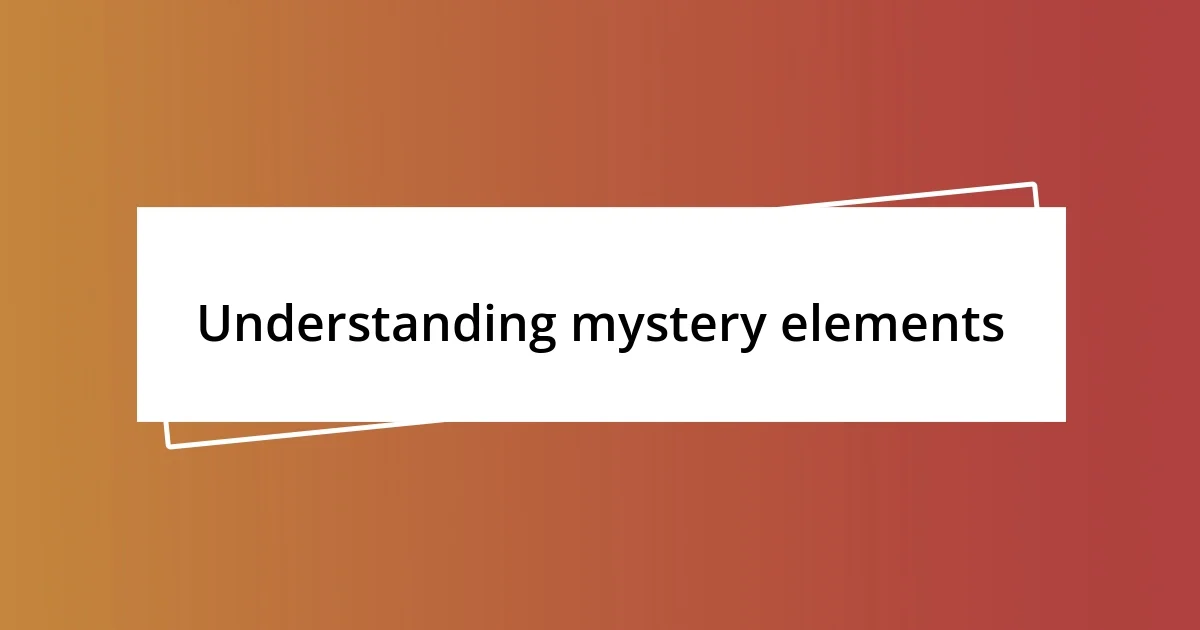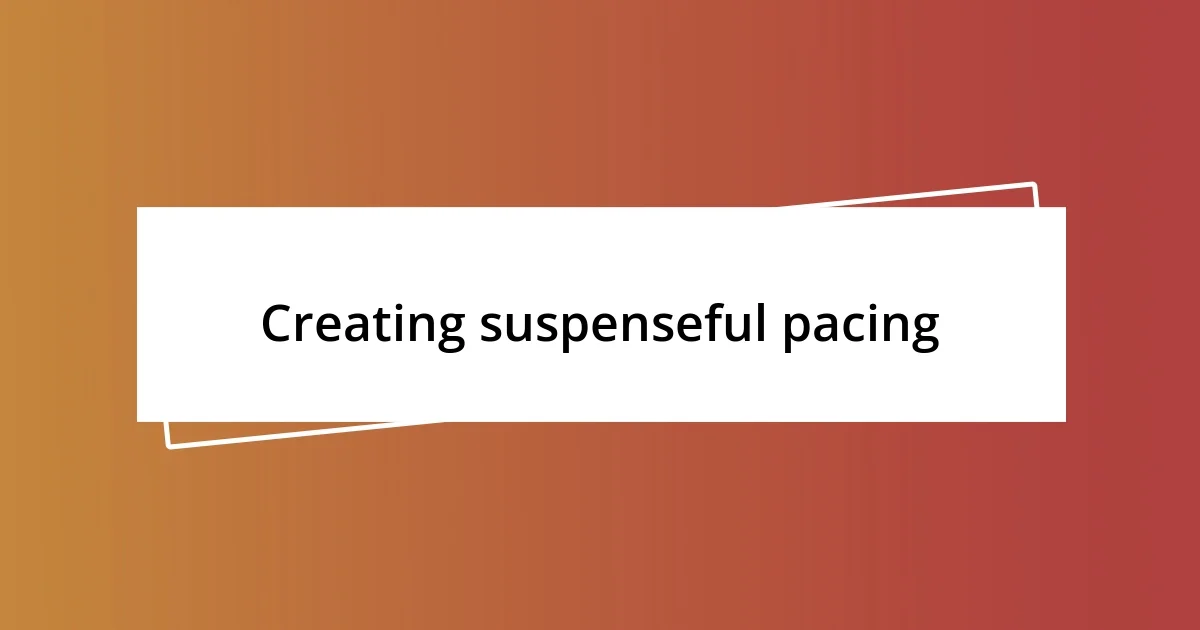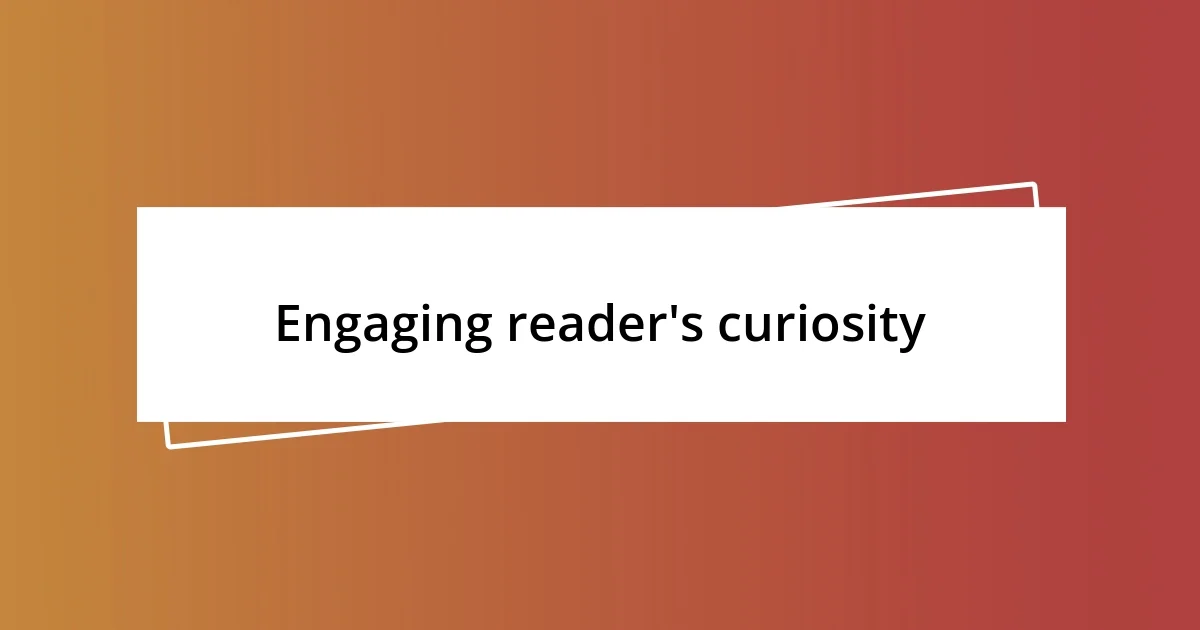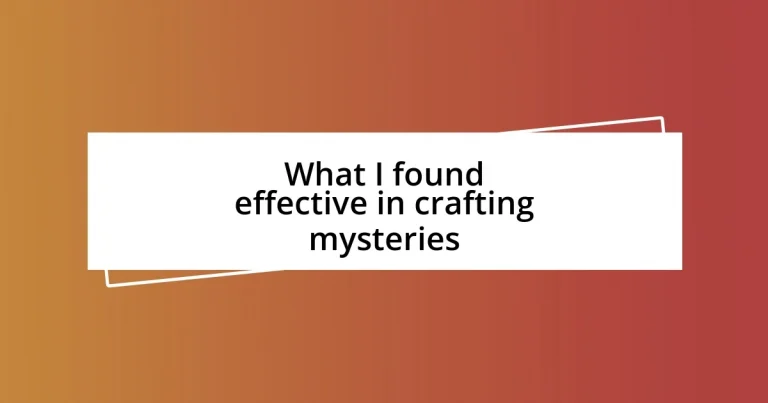Key takeaways:
- Effective mystery crafting relies on elements like foreshadowing, unreliable narrators, and well-developed characters to engage readers and create suspense.
- Intriguing plots benefit from strategic pacing, layering subplots, and presenting ethical dilemmas that provoke thought and emotional investment.
- Utilizing techniques such as red herrings, revealing clues through dialogue and environment, and maintaining reader curiosity are essential for creating a captivating narrative experience.

Understanding mystery elements
An essential element of crafting a compelling mystery is the art of foreshadowing. I remember the thrill I felt when I first noticed subtle hints in a story, like a character’s peculiar behavior or an object that seemed out of place. Have you ever wondered how a single clue can change the trajectory of a story? It prompts readers to question everything and keeps them engaged, searching for answers.
Another important aspect is the unreliable narrator. This can completely shift a reader’s perspective. Once, I was captivated by a mystery where I couldn’t trust the protagonist’s version of events. It made me realize that our biases shape how we perceive truth. Isn’t it fascinating how an unreliable voice can influence our understanding of the plot and other characters?
Character development is also critical in mysteries. I recall a gripping novel where the detective was flawed yet relatable. These complexities add depth. Readers often connect more with characters who struggle with their own secrets. Don’t you find that an imperfect character is much more interesting to follow? Showing growth, motivation, and backstory can deeply resonate, making the journey through the mystery all the more rewarding.

Crafting compelling characters
Crafting compelling characters is paramount in creating a mystery that resonates with readers. I’ve often found that when a character has layered emotions and a rich backstory, readers become more invested. I remember getting lost in a series where the protagonist grappled with personal demons alongside solving crimes. The connection I felt to their struggles made every twist that much more impactful. When you care about a character’s journey, the stakes feel much higher.
To create these compelling characters, consider the following:
- Flaws and Strengths: Give your characters contrasting traits. It creates realism and makes them relatable.
- Motivation: Clearly define what drives them. Personal goals will elevate your character’s significance.
- Backstory: Share snippets of their history. It adds depth and makes their actions more understandable.
- Relationships: Explore their connections with others. This can reveal much about their motivations and create tension.
- Development: Show their growth through the plot. A character that evolves keeps readers invested.

Developing intriguing plots
Developing intriguing plots involves a careful balance of tension and release, which keeps readers turning the pages. I often find that layering multiple subplots enhances the main storyline, giving readers a rich tapestry to unravel. For example, in one mystery I read, a seemingly unrelated sub-plot about a rival made the eventual reveal startling and satisfying. Have you ever experienced that moment when seemingly scattered threads come together to reveal the bigger picture? It’s like watching a magic trick unfold, leaving you both surprised and in awe.
In my experience, pacing is another crucial element to consider. Too fast, and the story risks leaving readers breathless; too slow, and they might lose interest. I remember reading a mystery where the author strategically placed cliffhangers at the end of chapters. Each time I thought about putting the book down, that little hook pulled me right back in. How do you maintain momentum in your own writing? I recommend experimenting with strategic pauses or revelations to keep the reader on their toes, inviting them to make predictions about what’s next.
Ultimately, the heart of an intriguing plot lies in its ability to evoke emotions and provoke thought. I once encountered a mystery that challenged my moral compass, forcing me to question what I would do in the protagonist’s shoes. Exploring ethical dilemmas not only deepens the plot but makes it more relatable. Have you ever reflected on your values while engrossed in a story? Crafting such poignant narratives leaves a lasting impression, making readers crave more.
| Key Elements | Effect on Plot |
|---|---|
| Foreshadowing | Builds suspense and keeps readers engaged |
| Unreliable Narrator | Shifts perception, creating surprise twists |
| Subplots | Add depth and complexity |
| Pacing | Controls reader engagement and anticipation |
| Ethical Dilemmas | Provokes thought and emotional investment |

Creating suspenseful pacing
Creating suspenseful pacing is an art that I believe can truly elevate any mystery. I’ve experienced firsthand how an expertly timed reveal can send shivers down your spine. For instance, while reading a novel where the protagonist was on the edge of a breakthrough, the author chose to interrupt that moment with an unexpected twist. It was like a sudden jolt, leaving me breathlessly waiting for the next turn. The anticipation during those moments is what keeps me glued to the pages.
What I’ve found effective is the use of rhythmic pacing—alternating between fast-paced scenes and slower, contemplative moments. One evening, I lost myself in a mystery where each burst of action was followed by a reflective pause that allowed me to digest the chaos. It mirrored the emotional intensity of real life; sometimes, after a whirlwind of excitement, all I want is to soak everything in. Have you ever found yourself reflecting deeply after a high-energy scene? That balance fosters a connection with the reader, making each revelation feel more significant.
Another tactic I cherish is layering suspense through timing. I recall a story where the climax was delayed just enough to build unbearable tension, leaving me on the brink of frustration and excitement. Those moments when the author skillfully weaves in hints but holds back on the information make the eventual payoff all the more satisfying. Isn’t it thrilling when all the clues finally click into place? That carefully orchestrated timing is essential for crafting a mystery that not only engages but also stirs genuine emotions.

Utilizing red herrings effectively
Utilizing red herrings is a fascinating technique that can truly strengthen a mystery. I remember reading a story where a seemingly innocuous character kept popping up, leading me to suspect their involvement in the crime. Each time I thought I had figured it out, the author skillfully redirected my attention, revealing that I’d been misled all along. Have you ever been so sure of a suspect, only to feel that rush of surprise when the truth unfolds? That deception adds a layer of intrigue that keeps readers invested.
When crafting red herrings, it’s essential to ensure they serve a purpose beyond mere distraction. I once plotted a mystery where I introduced a missing pet as a subplot to throw off the main investigation. It was delightful to create moments that made readers focus on the wrong clues, not realizing the significance of the real evidence hidden in plain sight. This technique not only adds depth but also engages readers in an active way, compelling them to piece together the right elements.
I’ve found that timing is crucial when revealing those red herrings. There’s an exhilarating satisfaction in dropping hints early on, then allowing readers to stew over them before unveiling their true nature later. In one narrative, I crafted a moment where a character’s alibi crumbled just when I thought I had it all figured out. The surprise brought me a mix of excitement and frustration that mirrored my own journey as a reader. Don’t you think that when done right, red herrings can transform a straightforward plot into an exhilarating puzzle?

Engaging reader’s curiosity
Engaging a reader’s curiosity often hinges on the strategic use of intrigue and questions. I recall a book I devoured, where each chapter ended with a provocative line that left me eager to turn the page. It felt like a gentle nudge, urging me to delve deeper into the enigma. Isn’t it fascinating how a simple question or cliffhanger can ignite that flame of curiosity within us?
Another element I’ve found effective in sparking curiosity is the gradual unveiling of character backstories. I once read a mystery featuring a detective whose past was shrouded in mystery. The slow reveal of their struggles and regrets created a bond between us, turning my intrigue into an emotional investment. Have you ever felt drawn to a character so much that you wanted to unravel their story just as much as the central mystery?
Conversely, I’ve noticed that withholding key details can be just as compelling. In a recent novel, critical information was shared only in snippets, forcing me to piece together the narrative puzzle. I felt like an investigator myself, driven by the need for answers. That sense of participation in uncovering the truth is what keeps readers flipping pages, don’t you think? It transforms passive reading into an active quest for knowledge and understanding.

Techniques for revealing clues
Revealing clues effectively is an art that can elevate a mystery from average to extraordinary. I once crafted a scene where a seemingly mundane object—a broken pocket watch—held the key to understanding the whole plot. By planting it early, I gave readers a chance to ponder its significance. Did you ever encounter an object in a story that turned out to be pivotal? That blend of subtlety and mystery creates an exhilarating moment of realization.
Another technique I find rewarding is the use of dialogue to reveal vital clues. In one of my stories, a casual conversation between two characters subtly hinted at a secret affair that was central to the mystery. Readers might overlook a seemingly innocuous line but then feel that jolt when they connect the dots later. It’s like a secret language—one that only the attentive reader gets to decipher, building a sense of camaraderie between them and the narrative.
I also believe in the power of environment when it comes to clues. In a mystery I developed set in an old library, I used the layout of the bookshelves to guide the characters and readers alike. A forgotten book held not just story context but actual clues connecting to the crime. Have you ever wandered around in a space that felt alive with secrets? It’s in those details that the physical setting breathes life into the story, drawing readers into the intricacies of the plot.














